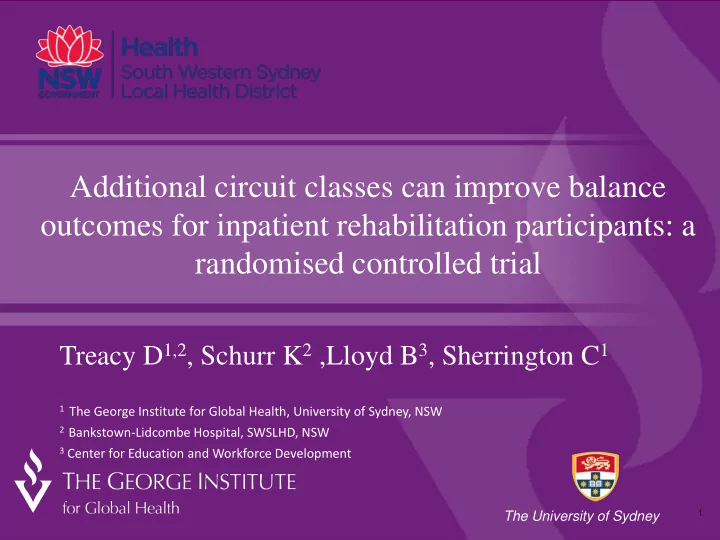

Additional circuit classes can improve balance outcomes for inpatient rehabilitation participants: a randomised controlled trial Treacy D 1,2 , Schurr K 2 ,Lloyd B 3 , Sherrington C 1 1 The George Institute for Global Health, University of Sydney, NSW 2 Bankstown-Lidcombe Hospital, SWSLHD, NSW 3 Center for Education and Workforce Development 1 The University of Sydney
Background Poor balance and mobility leads to an increased risk of falling Specific balance exercise has been shown to improve balance and reduce falls within the community setting Systematic reviews • - Howe et al 2007 • - Sherrington et al 2008 2
Standing balance circuit classes Seven different stations • - All stations aim to challenge people’s balance with minimal hand usage for support 6 minutes each Patients perform 6 of the 7 stations 2 therapists Maximum of 8 participants Therapist encourage to increase difficulty 3 times a week for 1 hour Participants count number of repetitions of exercise performed 3
Research Question Does two weeks of standing balance circuit classes, in addition to usual therapy, lead to greater improvements in balance among rehabilitation inpatients than usual therapy alone 4
Eligibility Criteria Admitted to the ward for rehabilitation No multi-resistant organism infection Be able to fully weight bear as ordered by a medical officer Suitable for a group exercise class with minimal supervision as determined by the treating physiotherapist. Able to stand for 30 seconds without physical assistance or the help of an assistive device 5
Recruitment and flow of participants Lost to follow Lost to follow Intervention up at 2 weeks up at 3 months group (n = 1) (n = 13) (n = 81) Admitted to Eligible for rehabilitation trial ward (n = 202) Control Lost to follow Lost to follow (n = 384) group up at 2 weeks up at 3 months (n = 81) (n = 0) (n = 11) 6
Compliance Number of classes completed n (%) Six 33 (41) Five 26 (32) Four 13 (16) Three or less 9 (11) Reason for not attending classes n (%) Discharged 47 (58) Not on ward 6 (7) Medically unwell 11(14) Refused 6 (7) Public holiday 11 (14) 7
Demographics Intervention Control Age (years), mean (SD) 82.6 (7.3) 81.4 (7.8) Gender, n female (%) 51 (62) 53 (65) MMSE (score/30), n (SD) 24.7 (3.1) 25.3 (3.2) Co-morbidities, n (%) Cerebrovascular accident 12 (15) 9 (11) Congestive cardiac failure 8 (10) 10(12) Ischemic heart disease 7 (9) 9 (11) Chronic obstructive pulmonary 12 (15) 11 (14) disease Dementia 8 (10) 7(9) Fall in the previous 12 months (83) (88) 8
Amount of practice Average (median) Range Repetitions per class 427 (412) 149 - 748 Repetitions per 2156 (2140) 433 - 4318 intervention period 9
Primary outcomes 10
Secondary outcomes - mobility 11
Secondary outcomes – self reported physical functioning 12
Secondary outcomes – falls Intervention Control Between-group (n = 81) (n = 81) differences* Falls at two 7 11 0.64 (0.21 to 1.99) weeks p = 0.446 Falls at three 60 54 1.13 (0.65 to 1.96) months p = 0.662 * Incident Rate Ratio 13
Secondary outcomes – LOS and re- admissions Intervention Control Between- 95% CI (n = 81) (n = 81) group p differences Rehabilitation 22.7 26.8 -4.1 -8.3 to 0.16 length of stay p = 0.059 Hospital re- 30 44 0.70* 0.42 to 1.18 admissons p = 0.184 * Incident Rate Ratio
Conclusion Two weeks of additional balance exercises delivered within a group environment in addition to usual therapy resulted in improved balance at two weeks and these improvement may be maintained at three months A high intensity challenging balance exercise program can be provided safely in a group environment setting Elderly patients with a high number of co-morbidities are able to perform a high number of repetitions of exercise Effects on falls is inconclusive 15
Recommend
More recommend